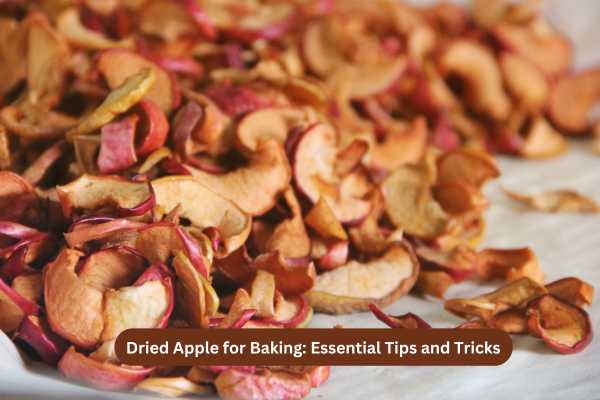Dried fruit has long been a baker’s secret weapon, and dried apple is one of the most versatile options available. With its natural sweetness, chewy texture, and concentrated flavour, dried apple can elevate everything from rustic breads to indulgent cakes. Whether you’re an experienced baker or just starting out, learning how to make the most of dried apples can transform your homemade treats.

In this article, we’ll explore how dried apple can be used in baking, offer practical preparation tips, and share ways to get the best results every time.
Why Choose Dried Apple for Baking?
Unlike fresh apples, dried apples have a longer shelf life, making them a reliable ingredient to keep in your cupboard. They provide a more intense apple flavour, as the drying process concentrates their natural sugars. Their chewy consistency also adds an appealing texture to baked goods.
Dried apple works particularly well in recipes where you want apple flavour without the excess liquid that fresh apples release during baking. This makes them ideal for muffins, scones, bread, flapjacks, and even festive bakes like Christmas puddings.
Selecting the Right Dried Apple
When choosing dried apple for baking, look for varieties that are:
-
Unsweetened – Many supermarket options are coated in sugar or syrup. Opting for unsweetened dried apple keeps your recipes balanced and prevents overpowering sweetness.
-
Sulphur-free – Some dried fruits are treated with sulphur dioxide to preserve colour. Sulphur-free options are more natural and often preferred for baking.
-
Uniformly cut – Evenly sized slices or chunks ensure consistent baking results.
If you enjoy experimenting, you can even make your own dried apples at home by oven-drying thinly sliced apples at a low temperature until crisp.
Preparing Dried Apple for Baking
Dried apples can be used straight from the packet, but in many cases, a little preparation improves both flavour and texture.
1. Rehydrating Dried Apples
Rehydration softens dried apple, making it juicier and easier to blend into recipes. Simply soak the apple pieces in warm water, fruit juice, or even spiced tea for 10–15 minutes, then drain before adding to your mixture.
2. Cutting to Size
If the dried apple slices are too large, chop them into smaller pieces with a sharp knife. Bite-sized chunks work best in muffins, biscuits, and flapjacks.
3. Coating with Flour
To prevent dried apple from sinking to the bottom of cakes or loaves, toss the pieces in a little flour before mixing them into your batter. This trick helps distribute them evenly.
Best Uses for Dried Apple in Baking
Dried apple is incredibly versatile, lending itself to both traditional and modern recipes. Here are some delicious ideas to inspire your next bake:
-
Apple and cinnamon muffins – A classic flavour combination where dried apple adds texture and sweetness.
-
Rustic apple bread – Combine dried apple with walnuts or pecans for a hearty loaf.
-
Apple flapjacks – Mix chopped dried apple with oats, honey, and butter for a chewy, fruity snack.
-
Festive bakes – Dried apple is perfect in Christmas puddings, fruitcakes, and spiced buns.
-
Apple crumble topping – Sprinkle finely chopped dried apple into crumble mixtures for an extra burst of flavour.
Flavour Pairings with Dried Apple
The gentle sweetness of dried apple pairs beautifully with a variety of flavours:
-
Spices: Cinnamon, nutmeg, and allspice enhance its natural warmth.
-
Nuts: Walnuts, pecans, and almonds add crunch and richness.
-
Dried fruits: Combine with raisins, cranberries, or apricots for layered fruitiness.
-
Citrus zest: Lemon or orange zest brightens up the flavour profile.
These pairings make dried apple a versatile ingredient in both everyday and festive baking.
Tips for Success
To get the best results when baking with dried apple, keep these professional tips in mind:
-
Don’t over-soak: Too much liquid can make dried apple mushy and affect the consistency of your bake.
-
Balance sweetness: Dried apple is naturally sweet, so you may need to reduce added sugar in your recipe.
-
Experiment with blends: Mix dried apple with other dried fruits for more complex flavours.
-
Storage matters: Keep dried apple in an airtight container in a cool, dry place to maintain freshness.
Health Benefits of Dried Apple
As well as being tasty, dried apples offer nutritional benefits. They are a source of dietary fibre, which supports digestion, and provide small amounts of vitamins and minerals, including potassium. While they do contain natural sugars, using them in baking allows you to cut back on refined sugar without compromising on flavour.
Final Thoughts
Dried apple is a humble yet powerful ingredient that can transform ordinary baking into something special. Its concentrated flavour, long shelf life, and adaptability make it a must-have for any UK baker’s pantry. By preparing it properly and combining it with the right flavours, you’ll unlock new levels of richness in your cakes, breads, and desserts.
Next time you’re planning a bake, consider reaching for dried apples—you may just discover your new favourite baking ingredient.

